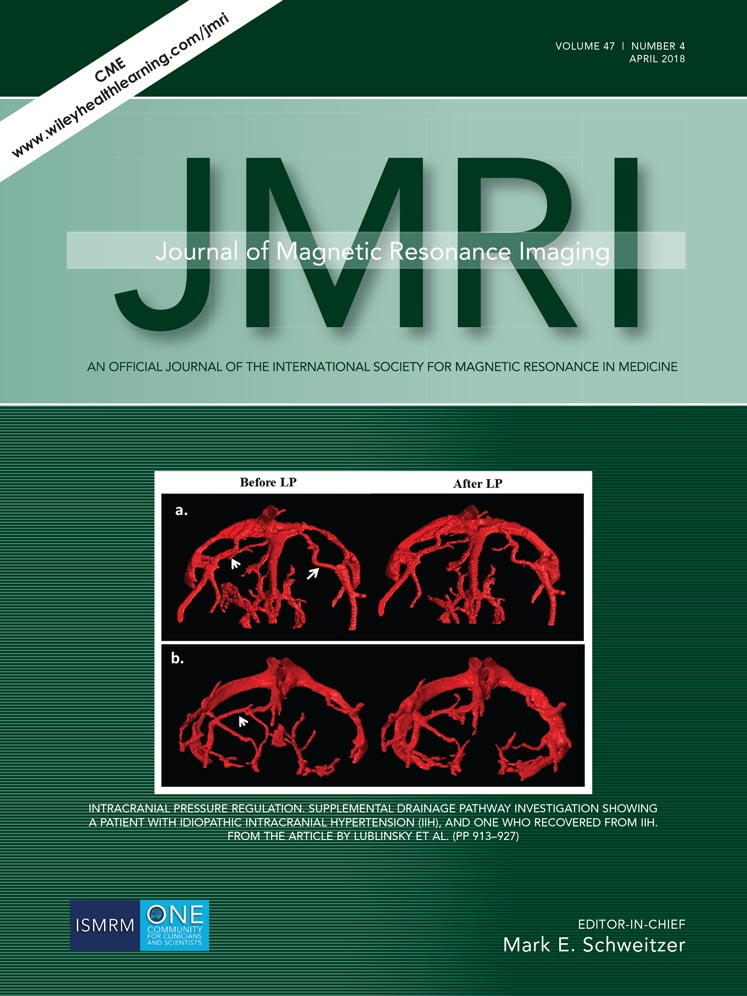MRI characterization of brown adipose tissue under thermal challenges in normal weight, overweight, and obese young men
Abstract
Purpose
To implement quantitative Dixon magnetic resonance imaging (MRI) methods for brown adipose tissue (BAT) characterization at inactive and cold-activated states in normal weight, overweight, and obese subjects. The hypotheses are that MRI characteristics of BAT would differentiate between nonobese and obese subjects, and activation of BAT in response to thermal challenges that are detected by MRI would be correlated with BAT activity measured by positron emission tomography / computed tomography (PET/CT).
Materials and Methods
Fifteen male subjects (20.7 ± 1.5 years old) including six normal weight, five overweight, and four obese subjects participated in the study. A multiecho Dixon MRI sequence was performed on a 1.5T scanner. MRI was acquired under thermoneutral, nonshivering thermogenesis, and subsequent warm-up conditions. Fat fraction (FF), R2*, and the number of double bonds (ndb) were measured by solving an optimization problem that fits in- and out-of-phase MR signal intensities to the fat-water interference models. Imaging acquisition and postprocessing were performed by two MRI physicists. In each subject, Dixon MRI measurements of FF, R2*, and ndb were calculated for each voxel within all BAT regions of interest (ROIs) under each thermal condition. Mean FF, R2*, and ndb were compared between nonobese (ie, normal-weight/overweight) and obese subjects using the two-sample t-test. Receiver operating characteristic (ROC) analyses were performed to differentiate nonobese vs. obese subjects. BAT MRI measurement changes in response to thermal condition changes were compared with hypermetabolic BAT volume/activity measured by PET/CT using the Pearson's correlation. In addition, BAT MRI measurements were compared with body adiposity using the Pearson's correlation. P < 0.05 was considered statistically significant.
Results
Obese subjects showed higher FF and lower R2* than nonobese subjects under all three thermal conditions (P < 0.01). ROC analyses demonstrated that FF and R2* were excellent predictors for the differentiation of nonobese from obese subjects (100% specificity and 100% sensitivity). FF changes under thermal challenges were correlated with hypermetabolic BAT volume (r = –0.55, P = 0.04 during activation, and r = 0.72, P = 0.003 during deactivation), and with BAT activity (r = 0.69, P = 0.006 during deactivation), as measured by PET/CT. FF and R2* under all three thermal conditions were highly correlated with body adiposity (P ≤ 0.002).
Conclusion
MRI characteristics of BAT differentiated between nonobese and obese subjects in both inactivated and activated states. BAT activation detected by Dixon MRI in response to thermal challenges were correlated with glucose uptake of metabolically active BAT.
Level of Evidence: 1
Technical Efficacy: Stage 3
J. Magn. Reson. Imaging 2018;47:936–947.




